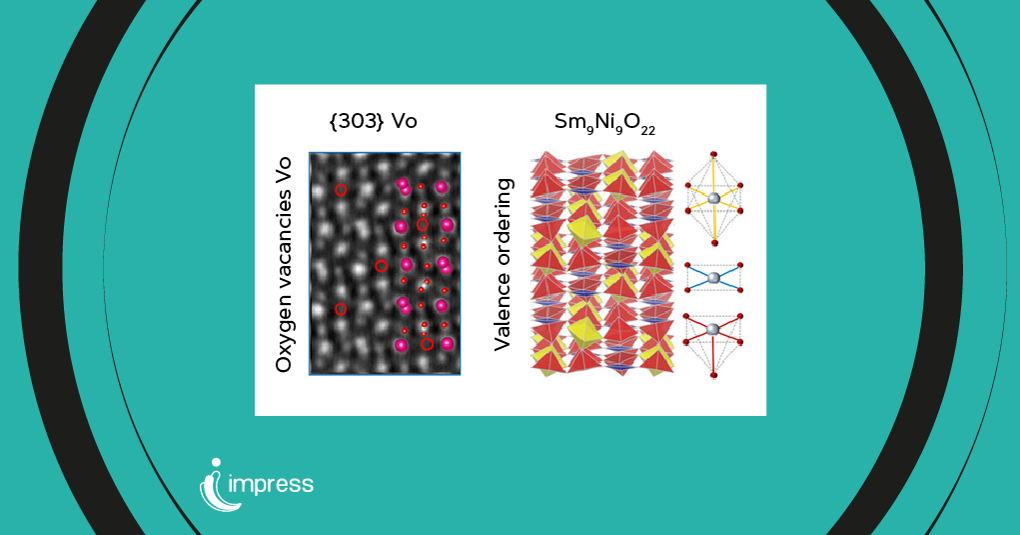
Discovery of a novel valence ordered nickelate phase paves the way for advances in nanosciences

The discovery of a novel valence ordered nickelate phase solves the mystery behind some of the complex physics exhibited by superconducting infinite-layer nickelates.
The synthesis of superconducting infinite-layer nickelates through topochemical reduction was one of the significant achievements in the recent years in the domain of unconventional superconductivity. Understanding this superconducting nature is intertwined with understanding competing order such as a 3 unit cell periodic charge order (an electronic modulation) reported in them.
Microscopy studies have indicated that this charge order is associated with an oxygen ordering in the sample, the structural aspect of such an ordering was a mystery. This was settled by the discovery of a new valence ordered nickelate phase Sm9Ni9O22 emerging from oxygen ordering.
The discovery was enabled by combined characterization with electron microscopy, synchrotron spectroscopy and ab initio techniques, the combination of which forms an example for advanced materials discovery and characterization.
A novel type of nickelate
The metal-hydride-based topochemical reduction process has enabled the creation of several thermodynamically unstable phases across various transition metal oxide series. This method has now produced a samarium nickelate with ordered nickel valences, showcasing a tri-component coordination configuration.
Unique electron properties
The newly synthesized nickelate, with the formula Sm9Ni9O22, was revealed through four-dimensional scanning transmission electron microscopy (4D-STEM). X-ray spectroscopy measurements and ab initio calculations have demonstrated the coexistence of these diverse nickel sites, leading to intense orbital polarization and charge-ordering. The ground state of this compound is characterized by strong electron localization, marked by the disappearance of the ligand-hole configuration at low temperatures.
Implications for electron microscopy
This discovery not only advances our understanding of nickelates but also aligns with the objectives of the IMPRESS project. The project’s goal of developing an interoperable platform for electron microscopy is supported by such findings, which highlight the importance of integrating different tools and using advanced imaging and spectroscopy techniques in exploring new material phases.
Key findings
The study, currently available in the journal ACS Nano, was conducted by an international research team from France, Hong Kong, China and Switzerland. Their collaborative efforts underscore the global significance of this breakthrough in material science.
Key themes addressed in this discovery include the following.
- Discovery of a new valence ordered nickelate phase Sm9Ni9O22.
- Exhibiting multi-valence, tri-component nickel coordination, and electron localization at low temperature.
- Having peculiar 3-unit cell periodicity, settling the debates on charge order in infinite-layer nickelates.
New avenues for research
The synthesis of this unique nickelate compound opens new avenues for research in materials science and other fields, including the development of advanced electronic devices. Future investigations may further explore the exotic phenomena associated with mixed valence states, enhancing our capabilities in nanoscale research.
“The discovery of this nickelate compound exemplifies the kind of innovative research that can be achieved with advanced imaging and spectroscopy techniques”, remarks Alessandro Nicolaou, Research Scientist at Synchrotron SOLEIL and IMPRESS Project Partner.
“Our results are fully aligned with the IMPRESS project, which aims to introduce an interoperable platform that can adapt to the diverse needs of scientific communities”, concludes Jean-Pascal Rueff, Research Scientist at Synchrotron SOLEIL and IMPRESS Project Partner.
Publication details
ACS Nano 2024, 18, 5, 4077–4088
Valence-Ordered Thin-Film Nickelate with Tricomponent Nickel Coordination Prepared by Topochemical Reduction
Aravind Raji, Zhengang Dong, Victor Porée, Alaska Subedi, Xiaoyan Li, Bernat Mundet, Lucia Varbaro, Claribel Domínguez, Marios Hadjimichael, Bohan Feng3, Alessandro Nicolaou, Jean-Pascal Rueff, Danfeng Li and Alexandre Gloter
doi: 10.1021/acsnano.3c07614